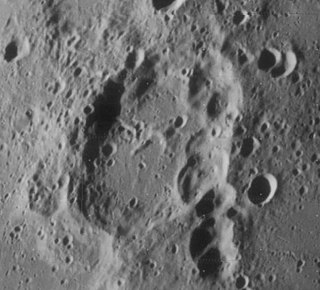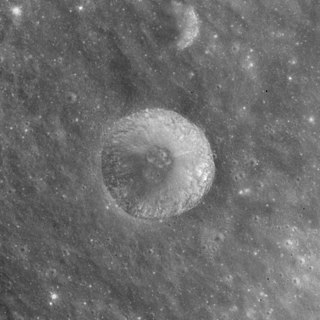
Cabannes is a lunar impact crater that lies in the southern hemisphere on the far side of the Moon. The rim has been worn by subsequent impacts, with a smaller crater overlying the southern rim. However the formation has not been significantly reshaped by nearby craters.

Langrenus is a prominent impact crater located near the eastern lunar limb. The feature is circular in shape, but appears oblong due to foreshortening. It lies on the eastern shore of the Mare Fecunditatis. To the south is the overlapping crater pair Vendelinus and the smaller Lamé.

Lamé is a lunar impact crater located astride the northeast rim of the crater Langrenus, to the east of Mare Fecunditatis. The eastern crater rim appears overlaid by a series of overlapping craters that form an intermittent chain flowing nearly a hundred kilometers to the south. The crater rim protrudes only slightly above the surrounding terrain, but it has a significant rampart where the rim lies within Vendelinus. In the middle of the floor is a slight ridge, forming a central peak.

Vendelinus is an ancient lunar impact crater located on the eastern edge of Mare Fecunditatis. To the north of Vendelinus is the prominent crater Langrenus, while to the southeast is Petavius, forming a chain of prominent craters near the eastern rim. Due to its location, the crater appears oblong due to foreshortening.

Al-Marrakushi is a small, relatively isolated lunar impact crater in the eastern Mare Fecunditatis. It is a circular, symmetrical formation, with inner walls that slope down to the midpoint. To the northeast is the prominent crater Langrenus. The mare near Al-Marrakushi is marked by ray material from its larger neighbor.

Acosta is a small lunar impact crater located just to the north of the prominent crater Langrenus, near the east edge of Mare Fecunditatis. To the west are the trio of Atwood, Naonobu, and Bilharz. Acosta is named after the Portuguese naturalist Cristóvão da Costa.

Lohse is a lunar impact crater on the eastern edge of Mare Fecunditatis. It is attached to the north rim of the larger crater Vendelinus. To the north is the prominent Langrenus. The interior of Lohse is rough, being partially covered by ejecta from Langrenus. It has a small central peak. An older impact is attached to the north rim, designated Langrenus E.

Born is a small lunar impact crater located near the eastern edge of the Moon, to the northeast of the prominent crater Langrenus. It was previously designated Maclaurin Y before being named by the IAU in 1979. Maclaurin itself lies to the north.

Atwood is a small lunar impact crater that is located on the Mare Fecunditatis, to the northwest of the prominent crater Langrenus. It forms a triple-crater formation with Naonobu attached to the north rim and Bilharz near the west rim.

Bilharz is a lunar impact crater that lies in the eastern part of the Mare Fecunditatis. It is the largest member of a close triple-crater formation with Atwood to the east and Naonobu to the northeast. To the southeast is the prominent crater Langrenus.

Naonobu is a small lunar impact crater named after Japanese mathematician Ajima Naonobu. It is located on the eastern Mare Fecunditatis, to the northwest of the prominent crater Langrenus, and it forms a triple-crater formation with the adjacent Atwood to the south and Bilharz just to the southwest. Naonobu and Atwood are separated by only a few kilometres.

Chamberlin is a lunar impact crater that is located on the far side of the Moon, just past the southeastern limb. It lies to the southeast of the crater Jeans, and Moulton is attached to the southeastern rim of Chamberlin. This crater is located in a part of the lunar surface that has undergone resurfacing of crater interiors, producing dark-hued crater floors.

Webb is a small lunar impact crater that is located near the eastern edge of the Mare Fecunditatis, in the eastern part of the Moon near the equator. It was named after British astronomer Thomas William Webb. It is to the north of the prominent crater Langrenus, and west of Maclaurin.

Barkla is a lunar impact crater that lies near the eastern limb of the Moon. It is located to the east of the prominent crater Langrenus, and was formerly designated Langrenus A before being renamed by the IAU in 1979. Due east of Barkla is Kapteyn, a formation only slightly larger with a similar size. Southwest of Barkla is the crater Lamé.

Maclaurin is a lunar impact crater that is located in the eastern part of the Moon's near side. It lies just to the southeast of the small Mare Spumans, and to the northeast of the prominent crater Langrenus. To the east-southeast is Gilbert.

Cleostratus is a lunar impact crater near the northwest limb of the Moon. It lies to the northeast of the crater Xenophanes, and west-southwest of the prominent Pythagoras. From the Earth this crater appears highly elongated due to foreshortening.

Kapetyn is a lunar impact crater that is near the eastern limb of the Moon, to the west of the crater La Pérouse. West of Kapetyn is the slightly smaller Barkla, and farther to the west-northwest is the prominent Langrenus. Von Behring is to the north-northeast.

Dellinger is a lunar impact crater that is located on the Moon's far side. It is attached to the southern rim of the crater Pannekoek. To the southeast lies the crater Marconi, and to the southwest is Chauvenet.

Fleming is a large lunar impact crater that is located on the Moon's far side, and cannot be seen from the Earth. It lies about a crater diameter to the east-northeast of Hertz, and to the northwest of Lobachevskiy.

Florensky is a lunar impact crater that is attached to the northeastern rim of the larger crater Vernadskiy. It is located on the far side of the Moon and cannot be directly seen from the Earth. The rim of this crater has been heavily eroded and it forms an irregular ring about the uneven interior. This crater was previously identified as Vernadskiy B before being assigned a name by the IAU in 1985.




















